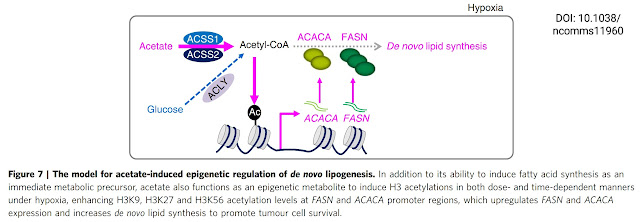What Does Vinegar/Acetate Do Under Hypoxia — That Is, Oxygen Deficiency?
I’ve written about the effects of vinegar/sodium acetate many times here — usually in a positive light. I’ve also frequently noted that adding HIF-1α to search queries often leads to very interesting studies. In my previous post, I explored the idea that combining vinegar, for instance, with overeating might lead to obesity — perhaps a healthier or less dangerous form than without vinegar. Acetate, produced by gut bacteria in the presence of excess polyunsaturated oils, facilitates the creation of new fats from acetate, glucose and amino acids by increasing insulin secretion.
Today, we’ll look at a study that goes even further. It shows that, under oxygen-deprived conditions, cancer cells readily use acetate molecules as a carbon source to produce fats and promote growth. This occurs through histone acetylation — activating fat-production-related genes. Interestingly, acetate concentrations don’t even need to be high. This aligns strongly with my earlier hypothesis: cells absorb acetate via MCT1 transporters expressed by lactate and during hypoxia, acetate enter cells more easily. I once speculated this could be a way to restore activity in pseudo-hypoxic or senescent cells. Although this study didn’t investigate MCT1 transporters directly, the outcome fits: acetate affects only hypoxic cells — those that are already compromised. Other studies have even looked at blocking MCT1 transporters to slow tumor growth, essentially stopping acetate from entering as a growth substrate.
 |
| Hypoxia: oxygen deficiency; FASN, ACACA: enzymes involved in fat synthesis |
It’s essential to recognize that cancer cells have a different metabolism from senescent cells. Though they share many traits, senescent cells don’t replicate. They’ve halted their cycle and await DNA repair, equipped with a broad range of repair enzymes and pathways. They remain in senescence because damaged DNA cannot be safely replicated, and they lack the energy for DNA repair or antioxidant support needed for oxidative phosphorylation. Acetate can provide both that energy and antioxidant defense, helping reboot gene expression. But this doesn’t apply to cancer cells — their DNA is irreparable, and they’re slated for disassembly by the immune system. So, acetate’s effect on cancer cells is counterproductive — it promotes growth. That said, if acetate can also reactivate senescent immune cells, it might not be all bad. Still, I’d avoid drawing conclusions from in vitro (test-tube) studies; what happens in vivo — in a living body — could be quite different.
The most important takeaway is this: acetate helps resolve oxygen deficiency by enabling the production of building blocks for tissue repair — membranes, blood vessels, etc. This promotes oxygen and nutrient supply to injured tissue, which certainly suffers from hypoxia. Acetate achieves this through histone acetylation in the nucleus — altering epigenetic information and turning on genes that make fats from acetate, glucose and amino acids, improving cell survival in harsh conditions.
 |
| Acetate activates the epigenetic regulation of new fat creation (de novo lipogenesis). |
In my previous post, I asked whether seed oils containing linoleic acid could themselves trigger de novo lipogenesis — the creation of new fats. This might allow their safe conversion into palmitic, stearic, and oleic acids, which can be securely stored long term in fat tissue. We can now say: yes, under hypoxia or pseudo-hypoxia, this is possible. Can linoleic acid induce pseudo-hypoxia? Yes — that, too, is possible through oxylipins (or increased lactate from the gut?). That completes the picture: the transformation of polyunsaturated fats to saturated and monounsaturated seems to be a protective response to hypoxic stress. This process requires a lot of NADPH, which — surprise, surprise — acetate also helps to solve.
So yes, acetate can indeed initiate fat production when needed (i.e. under oxygen deficiency), and it does so with care — activating antioxidant defenses in the process. If acetate is absent, hypoxia becomes dangerous: sensitive polyunsaturated fats remain unprotected, aren’t safely converted, and instead auto-oxidize into toxins. Makes sense, doesn’t it? Acetate is nature’s built-in fix for the issues posed by polyunsaturated plant fats. But our chemical food industry has nearly destroyed this system by antibacterial food protection, which also harms our gut microbes that produce acetate. As a result, especially older adults suffer from acetate deficiency and lack the antioxidant protection needed for fat metabolism. So, supplementing with vinegar/acetate could restore this original natural defense. Additionally, by breathing properly, you can improve tissue oxidation.
References:
Acetate functions as an epigenetic metabolite to promote lipid synthesis under hypoxia



Comments
Post a Comment